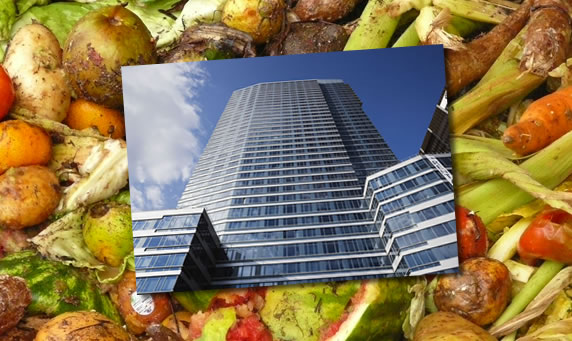
Some high-rise buildings, such as the 38-story Helena in New York City, have been able to offer composting to tenants, but despite the well-known positive benefits, onsite composting does present problems for high-rises.
New York City’s five boroughs produce an estimated 36,200 tons of garbage daily, totaling 13.2 million tons annually. Many commercial buildings have adopted recycling programs that focus on plastics, aluminum, and paper, but programs for compostable waste aren’t often utilized. Some waste management companies will separate wet trash pick-ups and divert compostable material to an outsourced composting facility, but these efforts rely on a high level of diesel fuel for transportation, ultimately releasing pollutants.
These startling statistics are what prompted Triangle Services to conduct a feasibility study covering onsite composting for high-rises. Some high-rise buildings, such as the 38-story Helena in New York City, have been able to offer composting to tenants by supplying organics bins on each floor’s trash room. Building staff members then gather the bins and set them out for collection by the City of New York Department of Sanitation; the contents are then transported to a local composting facility. But no readily available data existed on the associated savings and costs of an onsite composting program that would eliminate the emissions and environmental impacts of outsourced composting for high-rise buildings.
In the study’s proposed onsite composting program, compostable material would be diverted onsite before consolidating the trash stream. Diversion would ideally occur at dual levels:
- Initial separation of compostable materials in all kitchens, food preparation, and public eating areas via specialized “organic only” receptacles
- Secondary diversion from the general waste stream by designated sorters
Once collected, the materials would be transported to an onsite composting vessel, which would preferably placed at the rooftop level to eliminate the threat of pests or odor (and to save on storage costs). Composting vessels can range in scale from personal backyard containers to truck-loaded steel shipping vessels. In this study, an appropriately sized vessel that accommodates the scale of operation and volume of compostable material would be placed on the roof and loaded daily with collected material. Once full, the vessel would be closed for two weeks to allow the compostable waste to physically and chemically break down into nutrient-rich, organic soil that can be used and sold for top soil and fertilizing.
If one building can divert 40 pounds of organic waste a day, our study results indicate that the introduction of an onsite composting program at a single New York City high-rise has the potential to divert 5.2 tons of organic waste annually, resulting in a significant reduction of greenhouse gases, fuel consumption, and associated aerial pollution.
Composting can also offer other benefits:
- Reducing or eliminating the need for chemical fertilizers
- Remediating soils contaminated by hazardous waste
- Removing soils, oil, grease, and heavy metals from stormwater runoff
- Capturing and destroying 99.6% of industrial volatile organic chemicals (VOCs) in contaminated air
- Potential cost savings of at least 50% over conventional soil, water, and air pollution remediation technologies
While this high-rise feasibility study yielded a savings of approximately $3,000 in annual waste removal and waste transportation costs, the environmental benefits of such a composting project can be much greater. According to the U.S. Environmental Protection Agency’s Greenhouse Gas Equivalencies Calculator, 5.2 fewer tons of organic waste in a landfill translates to 5 metric tons of CO2 emissions not being released into the atmosphere. One year of composting at just one of Manhattan’s high-rises is equivalent to:
- 529 fewer gallons of gasoline consumed
- 11 fewer barrels of oil consumed
- CO2 emissions from 197 propane tanks from home barbecues
- Carbon sequestered by one acre of pine forest
- Carbon sequestered by 121 tree seedlings grown for 10 years
Despite the positive results of this study, onsite composting does present problems for high-rises, including additional labor requirements, elevator and roof access, availability of space, and diurnal/seasonal differentials. Although the environmental benefits of onsite composting are undeniable, the operational limitations and economic parameters prove prohibitive for high-rises at this time. However, the industry will continue to explore onsite composting options for high-rises.
NEGATIVES
When considering onsite composting in an urban environment, it’s important to consider the potential negative impacts:
Additional load on structural roof
Taking up valuable roof space that could be used for other sustainable benefits, such as green roof/vegetation, photovoltaics, stormwater capture, antennas, etc.
Operations and maintenance implications, including freight elevator access to the roof for hauling compost offsite and initial equipment installation
Odors and pest concerns from biodegradable material (particularly of concern for down-wind properties)
Staff members must be trained on the composting process, disposal of liquid leachate, and appropriate inclusion of materials (example: greasy foods and dairy shouldn’t be composted because they throw off the chemical composition of the material and interrupt the decomposition process)
Initial capital costs, which include system purchase and installation
Composting is generally more feasible at the ground level, where there are fewer space and transport restrictions.
James Ashworth
James Ashworth is the marketing communications manager at Triangle Services. To learn more, visit www.TriangleServices.com.

